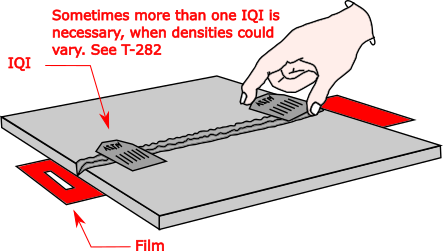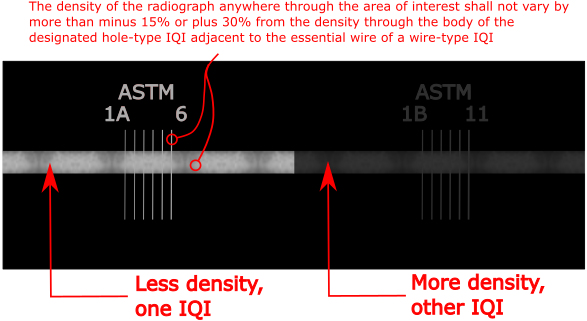Radiographic technique and density
By Carlos F Molina
This is my last article about radiology in tanks for readers who are studying for the API 653 exam. We will see
- Radiographic Technique
- Placement of IQIs
- Radiographic density
I make short comments about the parts of interest in the code, given that most of it is self explanatory. I accompany the comments with valuable images for better understanding.
[adToAppearHere]
RADIOGRAPHIC TECHNIQUE
According to ASME V T-271
A single-wall exposure technique shall be used for radiography whenever practical. […]. An adequate number of exposures shall be made to demonstrate that the required coverage has been obtained.
T-271.1 Single-Wall Technique. In the single-wall technique, the radiation passes through only one wall of the weld (material), which is viewed for acceptance on the radiograph.
Radiographs in tanks are single-wall technique. In the excerpt written above, I´ve erased the parts of the code that deal with the double-wall technique (when radiation passes through 2 walls) . Usually, the X-Ray technician will have to climb above a scaffold to put the Gamma Ray Camera in position. Some safety measures that need to be taken are the use of a survey meter close to the guide tube of the colimator, and a portable detection device in the technician´s body, along with the rules for working at height of your country. (I say this because I have been in QAQC and HSE roles and actually never technicians did have these safety measures in place)
PLACEMENT OF IQIs
T-277.1 Placement of IQIs.
(a) Source-Side IQI(s). The IQI(s) shall be placed on the source side of the part being examined, except for the condition described in (b).
When, due to part or weld configuration or size, it is not practical to place the IQI(s) on the part or weld, the IQI(s) may be placed on a separate block. Separate blocks shall be made of the same or radiographically similar materials (as defined in SE-1025) and may be used to facilitate IQI positioning. There is no restriction on the separate block thickness, provided the IQI/area-of-interest density tolerance requirements of T-282.2 are met.
(1) The IQI on the source side of the separate block shall be placed no closer to the film than the source side of the part being radiographed.(b) Film-Side IQI(s). Where inaccessibility prevents hand placing the IQI(s) on the source side, the IQI(s) shall be placed on the film side in contact with the part being examined. A lead letter “F” shall be placed adjacent to or on the IQI(s), but shall not mask the essential hole where hole IQIs are used.
As I said before, you´ll have to keep an eye on technicians. Sometimes they are too lazy to put the IQIs on the source side and instead put it in the film side, but don´t put the lead F letter required by the code.
T-277.2 Number of IQIs. When one or more film holders are used for an exposure, at least one IQI image shall appear on each radiograph […].
(a) Multiple IQIs. If the requirements of T-282 are met by using more than one IQI, one shall be representative of the lightest area of interest and the other the darkest area of interest; the intervening densities on the radiograph shall be considered as having acceptable density
 RADIOGRAPHIC DENSITY
RADIOGRAPHIC DENSITY
T-282. Density Limitations. The transmitted film density through the radiographic image of the body of the designated hole-type IQI adjacent to the essential hole or adjacent to the essential wire of a wire-type IQI and the area of interest shall be 1.8 minimum for single film viewing for radiographs made with an X-ray source and 2.0 minimum for radiographs made with a gamma ray source. For composite viewing of multiple film exposures, each film of the composite set shall have a minimum density of 1.3. The maximum density shall be 4.0 for either single or composite viewing. A tolerance of 0.05 in density is allowed for variations between densitometer readings.
T-282.2 Density Variation.
(a) The density of the radiograph anywhere through the area of interest shall not
(1) vary by more than minus 15% or plus 30% from the density through the body of the designated hole-type IQI adjacent to the essential hole or adjacent to the essential wire of a wire-type IQI, and(2) exceed the minimum/maximum allowable density ranges specified in T-282.1
When calculating the allowable variation in density, the calculation may be rounded to the nearest 0.1 within the range specified in T-282.1.
(b) When the requirements of (a) above are not met, then an additional IQI shall be used for each exceptional area or areas and the radiograph retaken.
(c) When shims are used with hole-type IQIs, the plus 30% density restriction of (a) above may be exceeded, and the minimum density requirements of T-282.1 do not apply for the IQI, provided the required IQI sensitivity of T-283.1 is met.
The following image illustrates point (1) in T-282. Whenever in a radiograph there is a variation of densities in the area of interest minus 15% or plus 30% from the density compared to the density measurable in the IQI, the radiograph should be rejected and it is recommended the use of another set of IQIs
This marks the end of the radiology articles in apiexam.com. I was going to make 50 questions out of this subject and put them in the article. However, I will send them to my mail list.
Thanks for your reading.


Leave a Comment